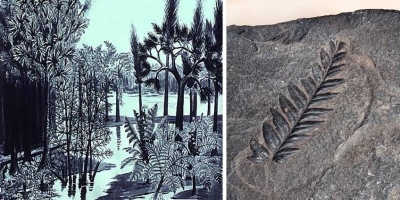
|
About 300 million years ago, in the Carboniferous period, there were huge tropical swamps filled with giant tree-like ferns. As the remains of the plants were buried and compacted in these huge, warm Swamps, they formed peat. As they sank deeper, heat and pressure changed the peat into brown coal. Further pressure changed it to black bituminous coal. |
Coal swamps are the classical terrestrial (land-based) ecosystems of the Carboniferous and Permian periods. They are forests that grew during the Palaeozoic Era (encompassing the Carboniferous and Permian) in which the volume of plant biomass dying and being deposited in the ground was greater than the volume of clastic (grains of pre-existing rock) material, resulting in a build-up of peat. This was subsequently buried, and eventually turned into coal over geological time. These swamps gave rise to most of the major, industrial-grade coal reserves that are mined today. The palaeontology of these coal-forming ecosystems is well known from the Carboniferous rocks of Euramerica (modern day Europe and North America), owing to the history of coal exploitation in these regions. However, extensive swamp areas that produced thick coal reserves have also formed at other times in the Earth’s history, most notably in the Permian. During the Early Permian, the coal swamps of Euramerica continued to flourish in Cathaysia (the tectonic blocks that formed modern day China), and throughout the Permian, coal swamps dominated by seed plants called glossopterids were found on the Southern Hemisphere supercontinent Gondwana (formed from modern day India, Australia, Antarctica, Africa, Madagascar and South America). The coal swamps of the Carboniferous and Early Permian formed primarily in tropical regions, whereas the Gondwanan coal swamps of the later Permian formed in higher-latitude temperate regions. Coal forests developed primarily in lowland areas such as river deltas, but there is a bias in the plant fossil record because fossilization is most likely to occur in these waterlogged habitats, meaning that fossils of drier, upland plant communities are much less common, so little is known of the plants that grew there.
Credit: palaeontologyonline.com
Picture credit: Google




